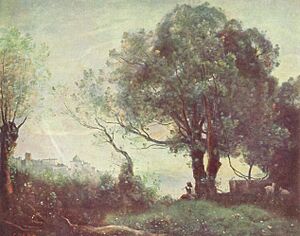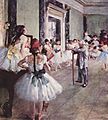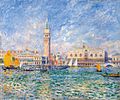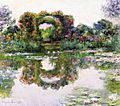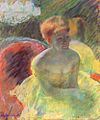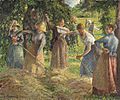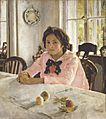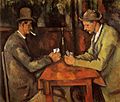Impressionism facts for kids
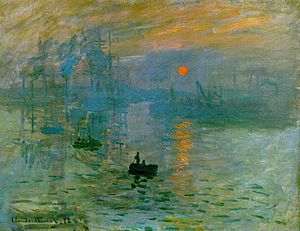
Impressionism is a special style of painting that started in France in the late 1800s. Impressionist paintings often show real-life scenes. They are painted quickly with brushstrokes you can easily see, and the colors are usually bright. The name 'Impressionism' came from a painting by Claude Monet. He called it Impression, soleil levant, which means "Impression, Sunrise". An art critic named Louis Leroy saw the painting and joked that all the artworks were just "impressions".
Most Impressionist painters used oil paints on canvas. Some also made watercolour paintings and prints. There are even a few Impressionist sculptures.
Contents
The Story of Impressionism
In the 1800s, most artists learned to paint at art schools. These schools were very strict. The popular painting style was called classicism. Classical paintings were always made indoors in a studio. They often showed stories from mythology (old legends). Artists would make many drawings before painting. The final paintings were very smooth and detailed.
At the same time, some painters loved to paint French landscapes and village people. They painted in a realistic way, different from classicism. They often made quick outdoor paintings, then finished them in their studios. Famous artists like Gustave Courbet and Jean-Baptiste Corot painted this way. Edgar Degas once said, "There is one master, Corot. We are nothing in comparison." A group of young painters who admired these artists became friends. They started painting together. This group included Claude Monet, Pierre-Auguste Renoir, Alfred Sisley, Frédéric Bazille, Camille Pissarro, Paul Cézanne, and Armand Guillaumin.
Every year, the art school in Paris held a big art show called the Salon de Paris. In 1863, an artist named Edouard Manet sent a painting called Lunch on the Grass. But the judges at the Salon refused to show it. Monet and his friends also had their paintings turned away. They were upset and met with Manet to talk about it. The Emperor Napoleon III allowed another exhibition. It was called the Salon des Refusés (Salon of the Refused). It showed all the paintings that had been turned away. Many people went to see this show. They soon realized there was a new art style, very different from what they were used to.
In 1872, Monet and his friends formed a group. They called it the "Cooperative and Anonymous Association of Painters, Sculptors, and Engravers." They started to organize their own art shows. In 1874, thirty artists held their first exhibition. The critic Louis Leroy made fun of their work. He wrote an article called The Exhibition of the Impressionists. People who visited the show also started using this name. Soon, the painters themselves began to use the name "Impressionists." They have been known by that name ever since.
They held eight exhibitions between 1874 and 1886. A art dealer named Paul Durand-Ruel helped them. He organized shows in London and New York. Slowly, their paintings became popular. Some Impressionists, like Monet and Renoir, lived to be old and famous. But others died very poor. The main artists known as "Impressionists" include Claude Monet, Auguste Renoir, Paul Cézanne, Camille Pissarro, Alfred Sisley, Edgar Degas, Berthe Morisot, Armand Guillaumin, Mary Cassatt, Gustave Caillebotte and Frederic Bazille.
Many artists worked with the Impressionists for a short time. Then they started trying new ideas. These artists painted in different ways. Together, they are called the Post-Impressionists. This group includes Georges Seurat, Paul Cézanne, Paul Gauguin, Henri de Toulouse-Lautrec, and Vincent van Gogh.
While French Impressionists were painting, artists in other countries also started painting outdoors. They used a similar broad style. Eventually, Impressionism spread across Europe, to North America and Australia. Some artists continued to paint in the Impressionist style even into the 20th century.
What Impressionists Painted and How
How photography influenced Impressionism
Before the Impressionists, many artists painted portraits. Before cameras were invented, painted portraits were the main way to show what a person looked like. But by the time Impressionists started painting, cameras were common. Photographers had studios where people could get their pictures taken. As cameras got better, photographers started taking "snapshots" of outdoor scenes and people.
Photography changed things for painters in two ways. First, it became harder for them to earn money by painting portraits. Many artists became very poor. Second, camera pictures often had interesting angles and views. These were not usually painted by artists. Impressionist painters learned from photographs. Many Impressionist paintings make you feel like you are right there, seeing the scene through the artist's eyes.
What Impressionists painted
Impressionist painters did not paint from their imagination. They didn't paint stories from literature, history, or mythology. Instead, they painted what they saw around them. This included their town, the landscapes where they went on holiday, their family, friends, and things in their homes. Sometimes, they were "commissioned" (given a job) to paint someone's portrait.
Impressionist painters liked to paint "ordinary" things from everyday life. They painted women washing clothes, ballet dancers practicing, horses getting ready for a race, and waitresses serving customers. Before the Impressionists, nobody thought these everyday subjects were interesting enough to paint.
Even though many Impressionist artists painted people, they are most famous for their landscape paintings. Impressionist painters didn't just make quick outdoor sketches and then finish big pictures in the studio. They wanted to capture the light and the weather.
How Impressionists painted
Impressionist painters looked for a "technique" (a way of doing something) to show light and weather in their landscapes. Light and weather change all the time. Sunlight on a landscape changes every minute as the Earth turns. Impressionist painters looked at earlier French artists like Camille Corot and Gustave Courbet. Courbet often took his paints outdoors. He made quick colored sketches to help him create larger paintings in his studio. The Impressionist painters were more interested in these quick sketches than the finished studio paintings.
Another artist, Eugene Boudin, used to sit on the beach with his oil paints. He made quick paintings of people on holiday. Sometimes, people would buy his paintings as souvenirs.
Claude Monet met Boudin. He learned that the best way to "capture" how a landscape looked at a certain moment was to paint small pictures very quickly. He didn't bother to mix the paints to make smooth, even colors. Impressionist painters used big brushstrokes of different bright colors. They let the colors mix on the canvas, instead of carefully mixing them on a palette first. By painting this way, without focusing on tiny details, Impressionist painters captured a realistic "impression" of the world they saw.
They painted many things: snow falling over a town, mist rising on a river in the pink morning light, people walking through a field of wheat with red poppies, sunlight shining through leaves on dancing people, a train blowing smoke in a big station, and water lilies floating on a pond under willow trees.
Most Impressionist landscape paintings are small. This made them easy for artists to carry outdoors. Some artists, especially Claude Monet, would take several canvases. As the day went on and the light changed, he would switch from one painting to another. He even rented a room where he could see Rouen Cathedral. This allowed him to paint it from his window at different times of day. Monet also painted a series of Haystack paintings. They showed haystacks in a field from different angles and in all kinds of weather, like bright sunshine, morning frost, and snow. Paintings done outdoors are called "plein air" paintings. Impressionist painters often went on painting trips together. This means we can compare many of their pictures.
Other Impressionist Art Forms
The word "impressionism" has also been used for other types of art, like writing and music. Octave Mirbeau is often called an Impressionist writer. In 1887, music critics said the works of Claude Debussy were Impressionist. Later, other composers were also called Impressionist, including Maurice Ravel, Paul Dukas, Erik Satie and Albert Roussel.
Gallery of Impressionist Paintings
Click on each image to enlarge it, to see the way each artist has used brush-strokes and colour.
Capturing the scene
Seeing like a camera
People outdoors
Changing seasons in the town
Light on water
Timeline: Lives of the Impressionists
The Impressionists

Related Pages
- Helen Gardner, Art through the Ages, Harcourt, Brace and World, Inc. ISBN: 0-15-503752-8
- Jurgen Schultze, Art of Nineteenth-Century Europe, Abrams, (1979) ISBN: 0-8109-8017-7
- Nathaniel Harris, The Impressionists, Viscount Books, (1984) ISBN: 0-600-35848-8
Images for kids
-
Claude Monet, Impression, soleil levant (Impression, Sunrise), 1872, oil on canvas, Musée Marmottan Monet, Paris. This painting became the source of the movement's name, after Louis Leroy's article The Exhibition of the Impressionists satirically implied that the painting was at most, a sketch.
-
J. M. W. Turner's atmospheric work was influential on the birth of Impressionism, here The Fighting Temeraire (1839)
-
Pierre-Auguste Renoir, Dance at Le Moulin de la Galette (Bal du moulin de la Galette), 1876, Musée d'Orsay, one of Impressionism's most celebrated masterpieces.
-
Alfred Sisley, View of the Canal Saint-Martin, 1870, Musée d'Orsay
-
Claude Monet, Haystacks, (sunset), 1890–1891, Museum of Fine Arts, Boston
-
Claude Monet, Woman with a Parasol - Madame Monet and Her Son (Camille and Jean Monet), 1875, National Gallery of Art, Washington, D.C.
-
Camille Pissarro, Boulevard Montmartre, 1897, the Hermitage, Saint Petersburg
-
Mary Cassatt, Lydia Leaning on Her Arms (in a theatre box), 1879
-
Camille Pissarro, Hay Harvest at Éragny, 1901, National Gallery of Canada, Ottawa, Ontario
-
Berthe Morisot, Reading, 1873, Cleveland Museum of Art
-
Claude Monet, Jardin à Sainte-Adresse, 1867, Metropolitan Museum of Art, New York., a work showing the influence of Japanese prints
-
Berthe Morisot, The Harbour at Lorient, 1869, National Gallery of Art, Washington, D.C.
-
Mary Cassatt, Young Girl at a Window, 1885, oil on canvas, National Gallery of Art, Washington, D.C.
-
Eva Gonzalès, Une Loge aux Italiens, or, Box at the Italian Opera, ca. 1874, oil on canvas, Musée d'Orsay, Paris
-
James Abbott McNeill Whistler, Nocturne in Black and Gold: The Falling Rocket, 1874, Detroit Institute of Arts
-
The Girl with Peaches (1887, Tretyakov Gallery) by Valentin Serov
-
Arthur Streeton's 1889 landscape Golden Summer, Eaglemont, held at the National Gallery of Australia, is an example of Australian impressionism.
-
Claude Monet, Water Lilies, 1916, National Museum of Western Art, Tokyo
-
Camille Pissarro, Children on a Farm, 1887
-
Frédéric Bazille, Paysage au bord du Lez, 1870, Minneapolis Institute of Art
-
Alfred Sisley, Bridge at Villeneuve-la-Garenne, 1872, Metropolitan Museum of Art
-
Armand Guillaumin, Sunset at Ivry (Soleil couchant à Ivry), 1873, Musée d'Orsay
-
Édouard Manet, Boating, 1874, Metropolitan Museum of Art
-
Alfred Sisley, La Seine au Point du jour, 1877, Museum of modern art André Malraux - MuMa, Le Havre
-
Édouard Manet, The Plum, 1878, National Gallery of Art, Washington, D.C.
-
Claude Monet, La Falaise à Fécamp, 1881, Aberdeen Art Gallery
-
Édouard Manet, A Bar at the Folies-Bergère (Un Bar aux Folies-Bergère), 1882, Courtauld Institute of Art
-
Edgar Degas, L'Absinthe, 1876, Musée d'Orsay, Paris
-
Edgar Degas, Dancer with a Bouquet of Flowers (Star of the Ballet), 1878, Getty Center, Los Angeles
-
Edgar Degas, Dancers at The Bar, 1888, The Phillips Collection, Washington, D.C.
-
Gustave Caillebotte, Paris Street; Rainy Day, 1877, Art Institute of Chicago
-
Pierre-Auguste Renoir, La Parisienne, 1874, National Museum Cardiff
-
Pierre-Auguste Renoir, Portrait of Irène Cahen d'Anvers (La Petite Irène), 1880, Foundation E.G. Bührle, Zürich
-
Pierre-Auguste Renoir, Two Sisters (On the Terrace), 1881, Art Institute of Chicago
-
Pierre-Auguste Renoir, Girl with a Hoop, 1885, National Gallery of Art, Washington, D.C.
-
Camille Pissarro, Washerwoman, Study, 1880. Metropolitan Museum of Art
-
Camille Pissarro, Conversation, c. 1881. National Museum of Western Art
-
Claude Monet, The Cliff at Étretat after the Storm, 1885, Clark Art Institute, Williamstown, Massachusetts
-
Mary Cassatt, The Child's Bath (The Bath), 1893, oil on canvas, Art Institute of Chicago
-
Berthe Morisot, Portrait of Mme Boursier and Her Daughter, c. 1873, Brooklyn Museum
-
Claude Monet, Le Grand Canal, 1908, Museum of Fine Arts, Boston
-
Georges Seurat, A Sunday Afternoon on the Island of La Grande Jatte, 1884–1886, The Art Institute of Chicago
-
Vincent van Gogh, Cypresses, 1889, Metropolitan Museum of Art
-
Paul Gauguin, The Midday Nap, 1894, Metropolitan Museum of Art
-
Paul Cézanne, The Card Players, 1894–1895, Musée d'Orsay, Paris
See also
 In Spanish: Impresionismo para niños
In Spanish: Impresionismo para niños


